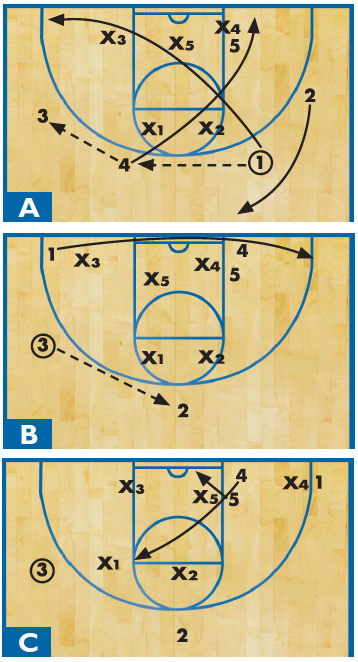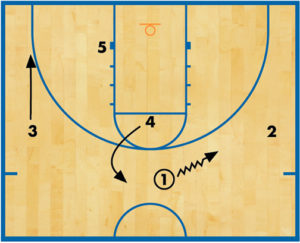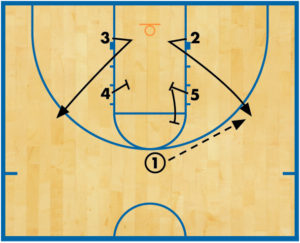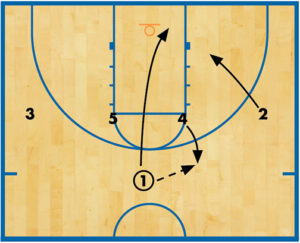3 quick-hitting plays to beat zone defenses
 The following plays are versatile and can work against just about any type of zone defense. The diagrams show the play as it’s run against a specific type of zone. But you’ll also find that they are easy to adapt and use against various zones.
The following plays are versatile and can work against just about any type of zone defense. The diagrams show the play as it’s run against a specific type of zone. But you’ll also find that they are easy to adapt and use against various zones.
‘Wisconsin’ vs. 1-3-1 zone
DIAGRAM A: Against a traditional 1-3-1 set, where the bottom defender covers the corner, this play is effective.
DIAGRAM B: 2 and 3 cross under 4, crossing near the strong-side lane line. 1 passes to 2 in the corner.
DIAGRAM C: In a 1-3-1, when 1 passes to 2, X1 covers 2 and X5 covers the post. 4 meets X5 in the lane and posts up on X5’s high side. 4 does this as a decoy. 3 moves high through the lane to screen X4 as 5 dives to the hoop. 3 gets out of the lane after 5 dives.
DIAGRAM D: 5 is open for an easy bucket on a pass from 2 because 3 has X4 sealed and 4 has X5 sealed.
 Vs. box-and-1
Vs. box-and-1
DIAGRAM A: For this diagram, S will be your star player. W should be a good shooter and P2 will be the better scorer of the two post players. 1 enters the ball by dribbling to the middle.
DIAGRAM B: S should run all over the court, using curls, cuts and various moves to take his or her defender all over the floor.
DIAGRAM C: 1 passes to W, while P1 sets a screen on P2’s defender. S continues to try to shake his or her defender.
DIAGRAM D: P2 pops out to the wing area, while W quickly ball reverses to 1 who looks to P2 for a quick 10- to 12-foot jump-shot.
DIAGRAM E: If the low defender fights through P1’s screen by coming over the top, then P1 and P2 should run a quick give-and-go play toward the basket.
 Baseline double vs. zone defense
Baseline double vs. zone defense
DIAGRAM A: The ball is reversed from 1 to 4 to 3. 1 dives to the ball-side corner. 4 dives to stack with 5 on the opposite post. 2 fills the point.
DIAGRAM B: 3 swings to 2 at the point. 1 runs off a baseline double screen by 4 and 5.
DIAGRAM C: When the defensive wing covers 1, 4 flashes to the high post and screens. 5 cuts to the basket.












